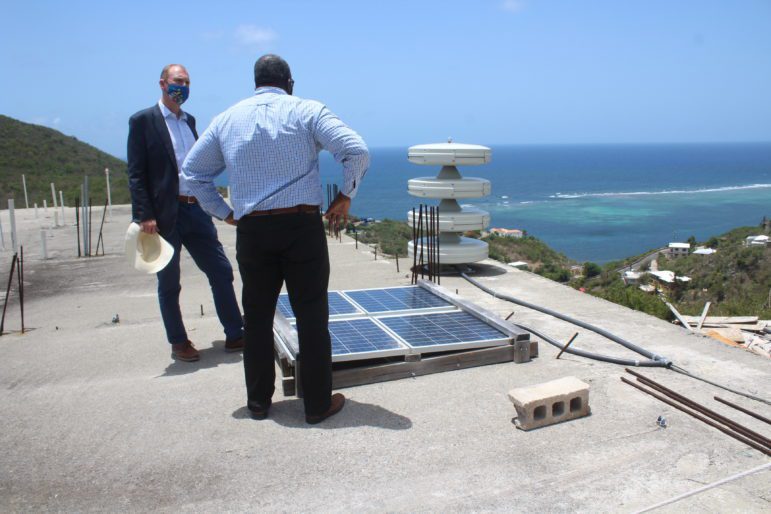As The Corona Virus Batters The Virgin Islands’ Tourism Economy, The Lifeblood Of The Caribbean, Residents Prepare For Hurricane Season Amid Worries About Social Distancing In Shelters.
Tortola, British Virgin Islands
Ask anyone in the British Virgin Islands what happened on September 6, 2017 and you will hear detailed accounts about how they survived Hurricane Irma, the Category Five hurricane that killed four people, injured 126 and flattened large swaths of the 60-island archipelago.
“All we saw was white,” recalled Christine Ferreira, a native Trinidadian who has lived in the territory for over 20 years. “The roof was blown out, and when we left the room we were sheltered in during the eye of the storm, we were blinded by the light.”
Islanders here call their experiences “survivor stories.”
Their resilience was on full display as they battled the Covid-19 pandemic.
“I think after Irma, we all felt like if we can get through that, we can get through anything,” said Christi Maddox, owner of Villas Virgin Gorda, a vacation rental agency on the island of Virgin Gorda. “Once we saw that the season was going to be over for tourists, we had to help our staff. A lot of them went through Irma and they know what it’s like to be out of work for a while.”
Some 30,000 people live on BVI’s four main islands. The islands recorded only eight confirmed cases of coronavirus and one death. Strict control of the border has helped keep the confirmed case number low, but sent the economy into a tailspin as tourism came to an abrupt halt.
Now British Virgin Islanders are trying to plan for two deadly scenarios: how to keep fighting the COVID-19 pandemic if or when hurricanes strikes.
“We do not get to pick a single battle in 2020,” said Premier Andrew Fahie, who has led the British run overseas territory for the 18 months “We have to ready and steady ourselves for keeping Covid-19 at bay, rebooting, re-energising, and reawakening our economy, and whatever the 2020 Atlantic hurricane season throws at us.”
On June 1, the first day of the Atlantic hurricane season, leaders of the British Virgin
Islands assured the people that every step is being taken to prepare for what they called an “active season.”
The public received messages from Mr. Fahie, Governor Gus Jaspert, and the Department of Disaster Management outlining standard procedures and reassuring residents that the government is taking both the pandemic and the hurricane season seriously.
Each week, the government publishes notices about the hurricane season. After each slight tremor or earthquake felt in the territory, officials make statements about preparedness.
While the government stresses the importance of each individual staying prepared for the worst, it was also making disaster preparation in its shelters.
In the main island of Tortola, the Long Trench Community Centre is a refurbished hurricane shelter, fitted with rooms that can easily separate families to keep in alignment with social distancing. The centre is one of five primary shelters on the island. It can house people during and after a disaster and is equipped with a generator and facilities to bathe and cook. Eight other secondary shelters, which lack kitchens or showers, are on Tortola. Secondary and tertiary shelters can only house people either during a disaster or for a couple of days after a storm.

Until recently, some residents were still living in the Long Trench Community Centre since they moved in after Irma. The shelters are being cleared to make space for those who may need them during disasters.
Government is currently reviewing accommodations on the sister islands of Jost van Dyke, Anegada, and Virgin Gorda that would allow for safe social-distancing practices.
Across Virgin Gorda, where houses still lay in ruin from Irma, are five shelters preparing for the season. Some are still not equipped with necessities like running water, but officials are working within the constraints of the pandemic.
Jaspert stated that moving around to the islands has been difficult lately, and a recent lockdown of the entire island of Jost Van Dyke has delayed plans to finalize the shelters.
There is only one shelter in Anegada and one in Jost van Dyke, but neither are able to provide refuge during a storm or earthquake since neither are primary shelters equipped with running water or kitchens.
Fortunately, residents from each of the sister islands have come together to form “Resilience Teams” to assist their communities with disaster preparedness. The teams include firefighters, field officers, public relations officers, government representatives and more.
During a meeting of the National Disaster Management Council on June 10, Jaspert said, “There is a lot of pressure on us, but we have one of the best-tested and strongest teams in the world, so I am confident in our ability to face this season.”
Both leaders referenced the resilience of the territory in the aftermath of hurricanes Irma and Maria in 2017, which devastated the territory. Along with the decimation of buildings, the event is a reference point for Virgin Islanders. Many will say “before Irma” when speaking about things that are now lost, and “since Irma” when speaking about things that have changed.
Fahie reminded the people that “conquering challenges is nothing new to Virgin Islanders.”